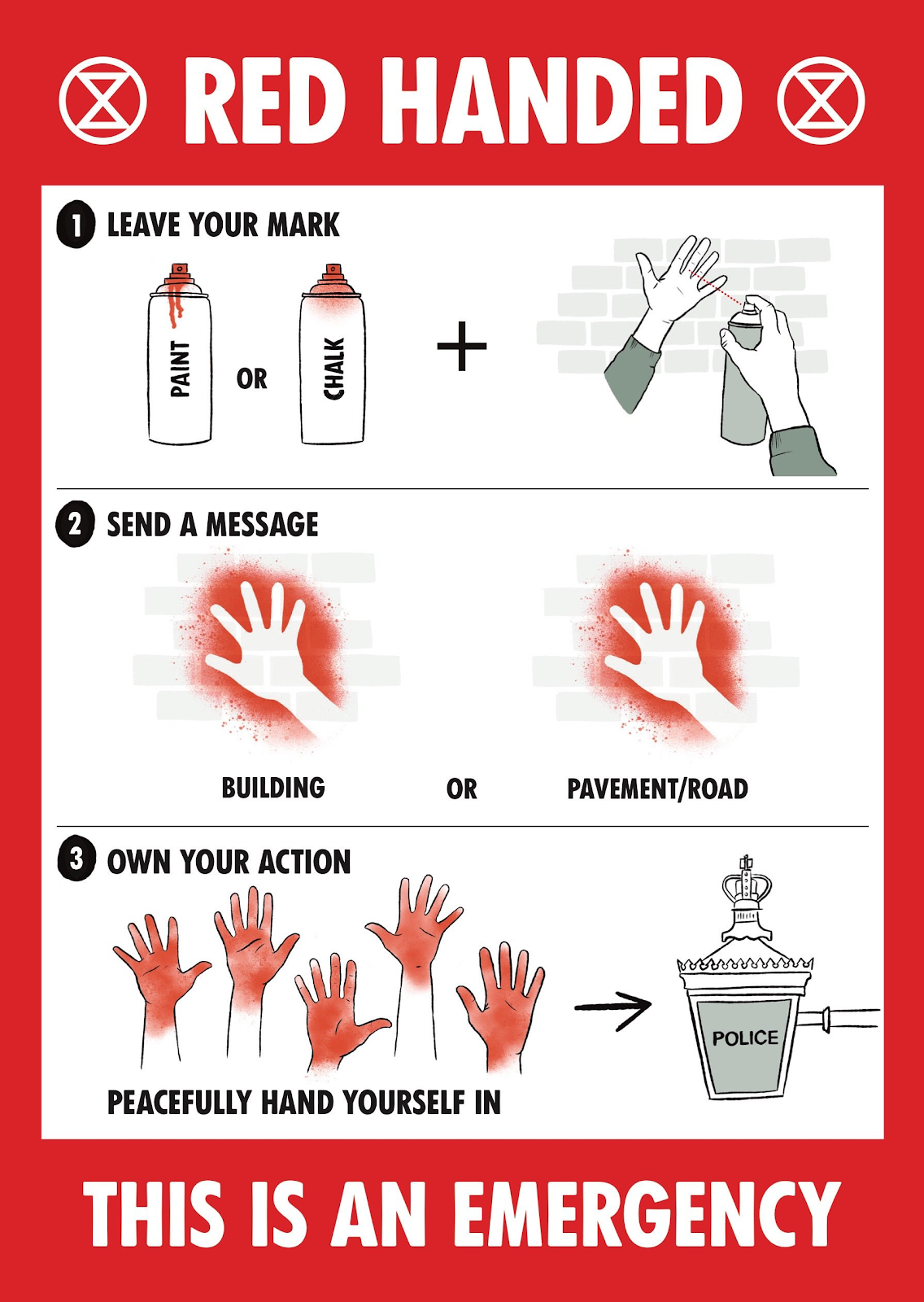Mano rossa
Da tradurre e scrivere bene
The Red Handed action involves spraying a stencil of your handprint with red chalk spray paint onto a significant building and then, handing yourself into the police. It can be scaled from a small number of rebels targeting one specific building up to a march of thousands of rebels in which there is a role for everyone.
If you want to scale it up, you can organise a mass participation march in which most people just spray their hands red and hold them up whilst a smaller number of rebels willing to face arrest walk on the edge of the march and spray paint their handprints onto buildings as you pass. It's best done in an area with lots of significant government buildings or a business district with fossil fuel and polluter companies offices so that you’ve got obvious targets for your handprints. However, if you’re in a town without any large government buildings then leaving lots of handprints on one small government building, or a trail of handprints on the sidewalk, bus stops or road of your local town is also really effective.
WHAT YOU’LL NEED
- Red chalk spray paint (this wipes off easily and causes less damage than normal spray paint)
PREPARING FOR THE ACTION
- Get the rebels prepared to do the criminal damage element of the action into an affinity group (or groups) of 8-12 people to support each other. Find out about affinity groups and how to form them [here]
- If you’re planning a march as well then read the Funeral March action design briefing and follow the steps to plan a safe mass turnout march.
- Assign some people to have bottles of chalk spray specifically for spraying the hands of non-arrestable members of the march. People get really excited to have their hand sprayed red and hold it up and it creates a real dilemma for police. In London when this action was first trialled, some people got arrested just for spraying their own hands red… which made the police look very silly. No charges were brought against them!
DESIGN
- Spray a red stencil of your hand on a significant building or on the street nearby.This could be a government building, fossil fuel company or similar.
- Use chalk spray (easier to wipe off) to cause less criminal damage, or ordinary spray paint to cause more.
- If you’re doing a march as well then some people can just march along, some can paint their hands red but do no criminal damage, some can spray the street (less likely to get you arrested) and others can spray buildings directly.
- Hand yourself in at your local police station and encourage the people who only sprayed their hands red but didn’t actually do any criminal damage to hand themselves in too. This will place the police in a dilemma: do we arrest people just for having red hands? Or do we not arrest people and potentially let them get away with a crime?
- If you get taken to court you should consider advancing a ‘necessity’ defence. In the UK this is broadly speaking a defence that says an act of criminal damage can be committed if it was an act of necessity to prevent serious harm to life or property (for example it would be legally justified to smash a window on a burning house to rescue a child inside). In the UK some protesters have been cleared of low level criminal damage charges by advancing this defence.
MESSAGING
- The action powerfully calls out a particular institution for its complicity in the CEE but at the same time acknowledges that we are all ‘red handed’ because we are all part of the system that is destroying life on earth.
- It demonstrates our conviction that we are telling the truth. We are so certain of the truth that we are prepared to raise our hands and take ownership of our own action.
- The message is also directed towards the police and attempts to create psychological disruption for individual officers about whether they should be arresting peaceful citizens or not.
LEGAL
- For those participating in the criminal damage element it’s important to get a full legal briefing on what the implications could be in your state. In the UK there is a threshold of £5,000 of criminal damage below which the charges and fines are less serious.


Nessun Commento